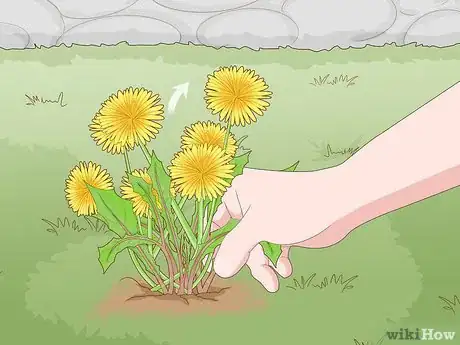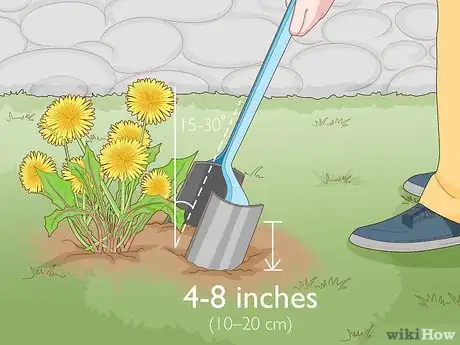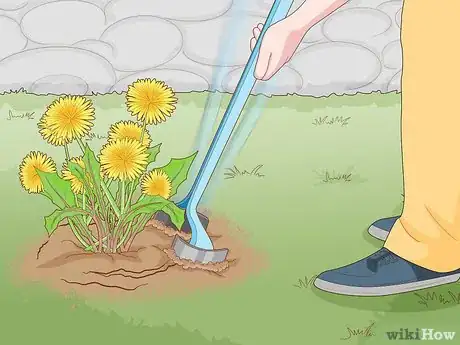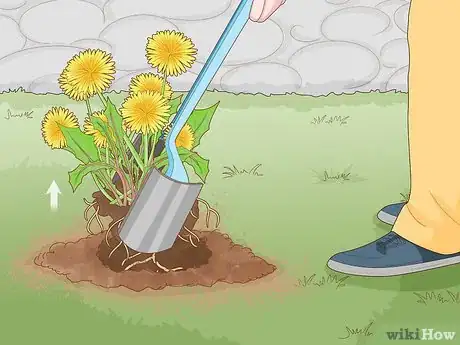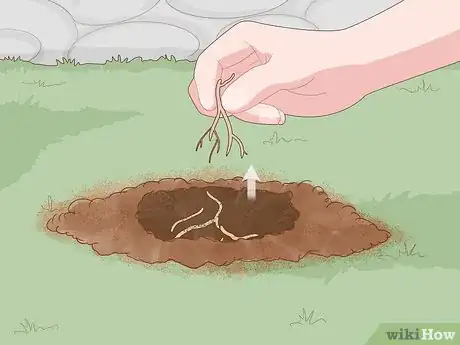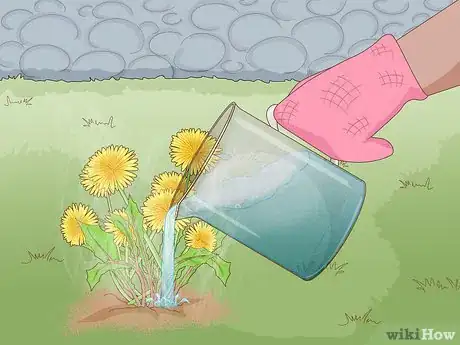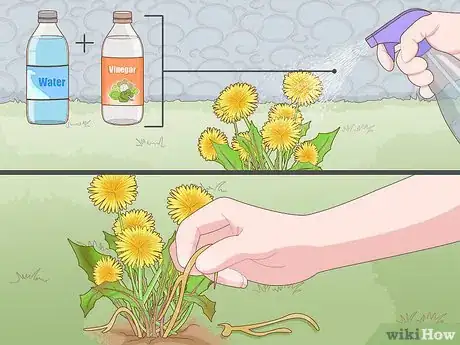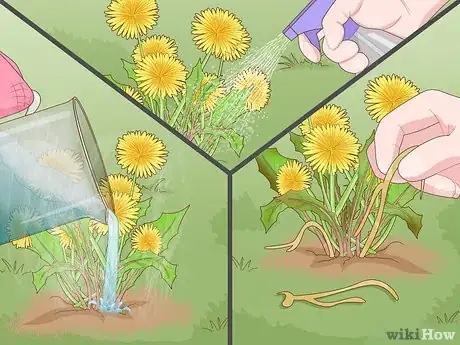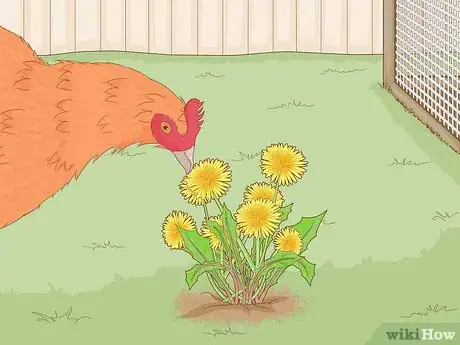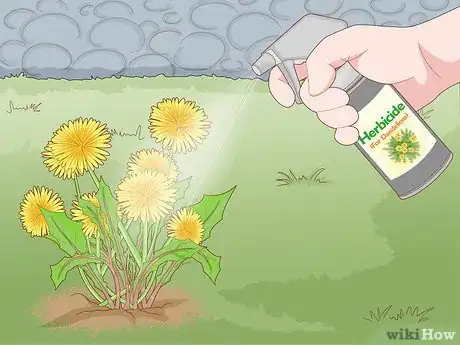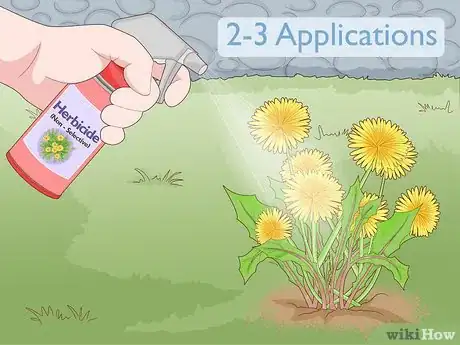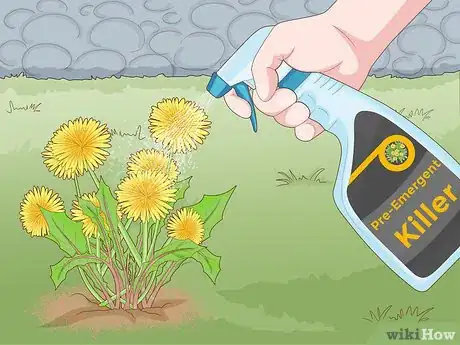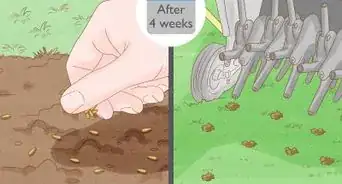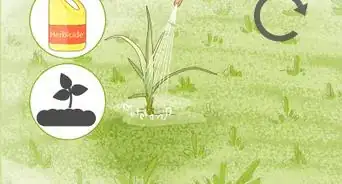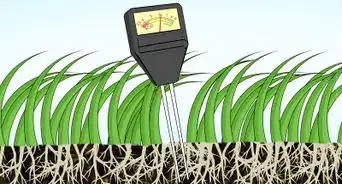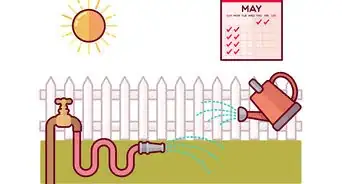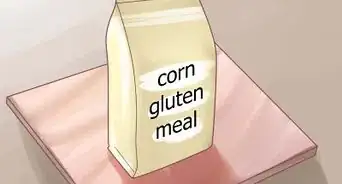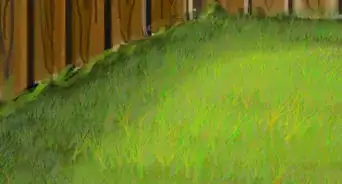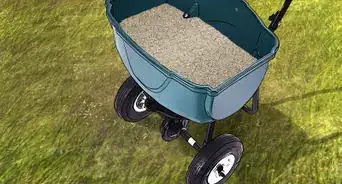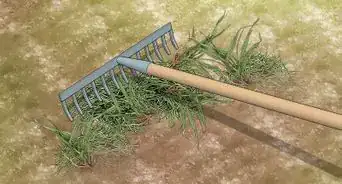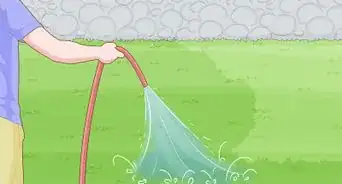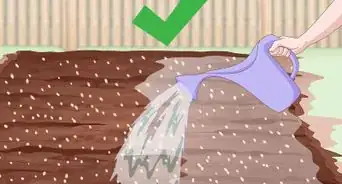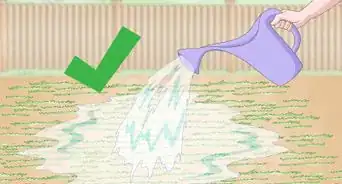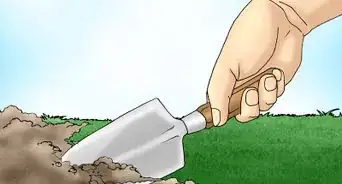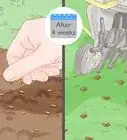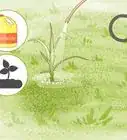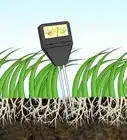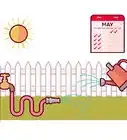This article was co-authored by Grant Wallace and by wikiHow staff writer, Eric McClure. Grant Wallace is a Landscaper and Owner of Grantlanta Lawn in Atlanta, Georgia. With over seven years of experience, he specializes in lawn maintenance and landscape installation. In 2012, he earned his BA from the University of West Georgia. Grant has been profiled in Shoutout Atlanta, Canvas Rebel, and Voyage ATL.
wikiHow marks an article as reader-approved once it receives enough positive feedback. In this case, several readers have written to tell us that this article was helpful to them, earning it our reader-approved status.
This article has been viewed 694,209 times.
Getting rid of dandelions is a balancing act between making sure that dandelions don’t grow back and not destroying the soil or other plants in your yard. The main way to get rid of a dandelion is to physically remove it, but if you leave any roots behind it may grow back within a week or two. You can also use an organic herbicide like vinegar or boiling water to kill the plant, although these methods may harm the soil and prevent future plant growth. If you want an easy route, you can opt for a selective or non-selective chemical herbicide depending on how deeply you care about the other plants in your yard. These chemical killers may accidentally kill other plants as well though.
Steps
Removing the Plants Physically
-
1Remove dandelions within a few days after it rains. If you try to physically remove dandelions when it’s dry out, the root will snap when you pull it up and the dandelion will simply regrow in a few weeks. When the ground is moist, the soil around the roots will be softer and more pliable. This will make it easier to remove the entire plant.[1]
- You can pick the plant by the stem if you just want to make your yard look better for a few days, but the dandelion will keep growing back.
-
2Push a spade or plant digger at an angle into the soil near the stem. Take a spade or plant digger and place the sharp point into the ground 3–6 inches (7.6–15.2 cm) from the plant. Angle the tool 15-30 degrees towards the plant’s roots. Push the blade 4–8 inches (10–20 cm) into the ground using the heel of your shoe or by applying downward pressure with your hand.[2]
- The taller the plant is, the deeper the roots are. To compensate for taller plants, make the angle of your tool a little narrower.
Tip: You can really use any tool with a sharp edge or point to get deep into the soil. A good knife will work if you don’t have any gardening tools. Exercise caution and work carefully if you’re using a bladed tool in your garden.
Advertisement -
3Loosen the soil around the dandelion with your tool. Grip the handle of your tool firmly and slide it 3–6 inches (7.6–15.2 cm) in both directions around the dandelion, working in a circle around the plant. Raise and lower your tool’s blade as you rotate around the plant to loosen the soil.[3]
- You only need to loosen the dirt on the side that you’re going to pull the plant from, but if you don’t mind digging a ditch, feel free to go all the way around the plant.
-
4Reach down and pull the dandelion out by the roots. Once you’ve loosened up the dirt between your tool and the plant, reach down into the soil. Follow the dandelion’s stem beneath the soil until you find the thick section of root that the smaller roots are attached to. This is the taproot. Grip it firmly and carefully pull it upwards to rip the entire plant out of the ground.[4]
- The taproot should be pretty easy to find—it’s like a really thick, strong stem that is sitting directly under the plant.
- If the plant is younger, the taproot may have a bend in it. Wrap your hand right around the junction where the taproot turns at an angle to remove it.
- You can compost the discarded plant if you want, but you may be surprised to know that you can actually use dandelions in a tea or dish.
-
5Inspect the opening and remove any remaining roots. Feel around in the hole where the plant was to see if there are any remaining roots. If you find any, remove them by hand. If there are any dandelion roots left under the topsoil, the plant will eventually grow back.[5]
- If you think you removed the entire plant but a new dandelion grows back in the same exact spot after a few weeks, you probably missed a root.
- Repeat this process for each dandelion in your yard or garden.
Getting Rid of Dandelions Organically
-
1Pour boiling water over the plants to kill them. Fill a medium-sized pot with tap water. Heat it on medium-high until the water reaches a rolling boil. Put on a pair of oven mitts and carry the pot carefully out to your yard or garden. Slowly pour the boiling water over the dandelion. Make sure that you get the head and stem of the plant and allow the water to seep into the soil near the root.[6]
- Repeat this process at least 2 times a day, every day. Continue to do this until the plant has totally withered and died. Remove the stem and discard the plant.
- Be really careful to not burn yourself as you’re walking around with a hot pot.
Warning: This method kills the taproot, the stem, and the head at the same time. It may damage the grass or plants around the dandelion though.
-
2Spray the plants with vinegar and water to kill them. Get a white vinegar with an acidic level of 20-25%. Fill a spray bottle halfway with the vinegar. Then, fill the rest of the bottle with tap water. Shake the bottle to mix it together and turn the nozzle on your bottle to a medium setting. Spray each section of the plant. Continue spraying the plant once a day until it’s dead and then remove the stem by hand.[7]
- Don’t forget to spray the underside of the leaves and head.
- You can try adding salt to the solution if you don’t think the vinegar is working.
-
3Combine boiling water and vinegar with physical removal to ensure eradication. One of the easiest ways to ensure that you fully remove a dandelion is to combine boiling water, vinegar, and physical removal. Spray the plant every day with the vinegar solution to kill and weaken the plant. Then, use a spade or plant removal tool to physically remove the plant by the taproot. Finally, ensure that any smaller pieces of root don’t grow back by filling the hole you made with boiling water.[8]
- This is the most thorough way to remove dandelions, but it will absolutely destroy the soil and any nearby plants. You won’t be able to grow anything in this section of your lawn for a while.
-
4Raise chickens in your yard and let them eat the dandelions. Chickens absolutely love to snack on dandelions. If you live in a rural area where you can feasibly raise chickens, go ahead and let them loose in your yard when the dandelions grow. They’ll snack on them down to the stem.[9]
- This won’t actually remove the dandelion, but when it grows back you can simply release the chickens again.
- Dandelions aren’t bad for chickens, but other common weeds may be.
Using Chemical Killers
-
1Use a selective herbicide to target dandelions specifically. Get a dandelion-specific herbicide from a local gardening or lawncare store. Read the label and follow the manufacturer’s instructions to ensure that you apply the herbicide to the dandelions correctly. Every herbicide’s instructions are different, but in general, they will take a few days to begin killing the unwanted plants.[10]
- Selective herbicides are designed to kill a single species of weed or plant while non-selective herbicides are designed to kill every major type of weed. A selective herbicide is usually less effective than a non-selective herbicide. But if you’re trying to grow any other plants in your yard, the non-selective herbicide can be a risky proposition.
-
2Choose a non-selective herbicide to kill dandelions and other weeds. If you want to target other weeds in addition to the dandelions, opt for a non-selective herbicide. Follow the manufacturer’s instructions to apply the herbicide to your lawn. Typically, it only takes non-selective herbicide 2-3 applications to completely kill weeds.[11]
- Non-selective herbicide may damage other plants or flowers in your lawn.
-
3Use a pre-emergent weed killer after removing plants or in the spring. Pre-emergent weed killer prevents the germination of seeds that are already under the topsoil. Using a pre-emergent treatment will prevent any dandelion roots or seeds from growing or developing into mature plants. Get a pre-emergent treatment from a lawn care store and spay it over your lawn in the spring or after removing dandelion plants to keep them from coming back.[12]
Tip: Pre-emergent weed killer doesn’t tend to endanger the other plants in your yard or lawn.
Community Q&A
-
QuestionWill the dandelions choke off your lawn if there are too many?
 Community AnswerYes, dandelions will take over entire sections of a lawn if the conditions are ideal for seeding and germination of the dandelion. It will spread rapidly, and within a few seasons you will see some sections of lawn exclusively covered in dandelions.
Community AnswerYes, dandelions will take over entire sections of a lawn if the conditions are ideal for seeding and germination of the dandelion. It will spread rapidly, and within a few seasons you will see some sections of lawn exclusively covered in dandelions. -
QuestionWhen a yellow dandelion head is sprayed with Weed-B-Gone and the head later turns to seed, have the seeds been killed, too?
 Community AnswerNo, there is no herbicide that kills seeds. If the dandelion has gone to seed then the Weed-B-Gone application was not successful. A broad leaf herbicide is only effective on dandelions that are going through vegetative growth rather than under stress and in flower stage. It is absorbed through the leaves and broken down by the plant when in growth. Spraying during dormancy or seeding is far from ideal. Using a surfactant will help break through the wax coating on the leaves and give better results.
Community AnswerNo, there is no herbicide that kills seeds. If the dandelion has gone to seed then the Weed-B-Gone application was not successful. A broad leaf herbicide is only effective on dandelions that are going through vegetative growth rather than under stress and in flower stage. It is absorbed through the leaves and broken down by the plant when in growth. Spraying during dormancy or seeding is far from ideal. Using a surfactant will help break through the wax coating on the leaves and give better results. -
QuestionWhat do I do with the hole when the dandelion has been removed?
 Community AnswerYou can fill it with a little soil and if you have some, throw some grass seed on it.
Community AnswerYou can fill it with a little soil and if you have some, throw some grass seed on it.
Things You’ll Need
Removing the Plants Physically
- Spade or digging tool
Getting Rid of Dandelions Organically
- Pot
- Water
- Vinegar
- Spray bottle
- Chickens
Using Chemical Killers
- Selective or non-selective weed killer
- Pre-emergent weed treatment
Expert Interview
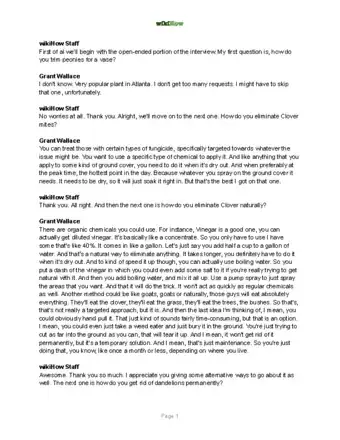
Thanks for reading our article! If you'd like to learn more about getting rid of dandelions, check out our in-depth interview with Grant Wallace.
References
- ↑ https://www.cleveland.com/insideout/2015/05/post_298.html
- ↑ https://www.cleveland.com/insideout/2015/05/post_298.html
- ↑ https://www.cleveland.com/insideout/2015/05/post_298.html
- ↑ https://www.weekendgardener.net/how-to-get-rid-of-kill-dandelions-in-lawns/
- ↑ https://www.weekendgardener.net/how-to-get-rid-of-kill-dandelions-in-lawns/
- ↑ https://www.cleveland.com/insideout/2015/05/post_298.html
- ↑ https://www.weekendgardener.net/how-to-get-rid-of-kill-dandelions-in-lawns/
- ↑ https://www.weekendgardener.net/how-to-get-rid-of-kill-dandelions-in-lawns/
- ↑ https://www.hobbyfarms.com/14-toxic-plants-your-chickens-must-avoid-3/
About This Article
To get rid of dandelions in your lawn, simply mow over them or dig them up out of your yard. If you'd prefer to try a more permanent solution, try pouring boiling water over them a few times a day for 3 days to kill them. Alternatively, spray your dandelions with white vinegar or pull them out by the root and spray the hole that's left behind to kill any roots. Another way to get rid of dandelions is to pile a tablespoon of salt around the base of each weed. To learn how to use chemicals to get rid of your dandelions, keep reading!
